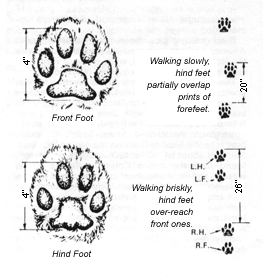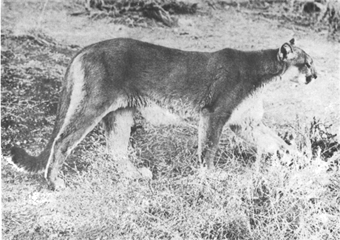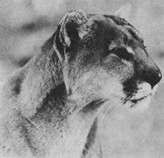|
 |
Publications
Cougar in British Columbia
|
Printed March, 1994
The cougar, the largest wild cat native to British Columbia,
is an imposing but evasive member of our wildlife. His secretive
habits, and sometimes astounding predatory abilities (the cougar
is capable of killing a 600 pound moose or elk), have resulted
in a wealth of human misconceptions and irrational fears. In
some instances, "control" programmes responding to
these fears placed severe and unwarranted hunting pressure upon
cougar populations.
Appearance and Distribution
The adult cougar is a large animal: the heaviest recorded was
an Arizona cougar which weighed 276 pounds. Although there have
been several cougar taken in British Columbia weighing between
190 and 210 pounds, the average adult male weighs about 125
pounds and the female 100 pounds. Large adult males may measure
9 feet in length, including a 30-inch tail.
The fur is short and, in British Columbia, ranges in colour
from reddish-brown to a grey-brown, with light underparts. Very
young kittens are spotted, with ringed tails; this coloration
is gradually lost as young cougar reach adulthood. Adults are
unmarked.
Black cougar have been reported from South America and one
was reported several years ago in the North Okanagan area, while
white or very light-coloured cougar are infrequently reported.
The cougar is found only in the Western Hemisphere, from northern
British Columbia to Patagonia in southern Argentina. In Canada,
the cougar has been recorded from British Columbia east to New
Brunswick. Distribution in British Columbia extends north from
the United States - British Columbia border to Big Muddy River
on the Alaska Highway South of about 54 degrees latitude cougar
are generally found from the British Columbia-Alberta border
west, to and including, most coastal islands. Cougar have not
reached the Queen Charlotte Islands.
In response to human contact with the cougar over such an extensive
geographical area, many local names have developed for this
impressive animal: cougar, puma, mountain lion, deer tiger,
Indian devil, and Mexican lion are a few of their descriptive
titles.
Territory
The territory or home range of individual cougar has been recognized
for many years, but only recently have accurate limits been
assigned to these ranges. Early estimates suggested that cougar
maintained home ranges of up to, or greater than, 100 square
miles. In Idaho, where the winter territory of cougar was examined,
females on the study area maintained territories of 5 to 20
square miles. Females with kittens required larger ranges than
females without kittens, and some overlap of female ranges was
noticed. Males occupied larger territories - one male occupied
a range of 25 square miles. Resident males did not overlap ranges.
Transient cougars moved through occupied ranges, but avoided
residents.
An occupied range is clearly marked by the resident cougar.
This is done by a series of visual and olfactory signals which
are easily recognized by other cats. Scratch piles are made
at regular locations on which the cougar may urinate or defecate.
All cougar make these marks, but males mark more frequently
than females, and the marks are more numerous during periods
of high populations.
One old male who had taken up residence on a small coastal
island (about 4 square miles) was found to have made no scratch
piles (at least none was found). With no other cougar on his
island there was no need to mark his territory.
Food Habits
The predatory activities of the cougar are legendary, and prey
species in British Columbia range from large animals to mice,
and include deer, porcupine, beaver, varying hare, moose, elk,
wild sheep, mountain goats, black bear (cubs), grouse, coyote,
other cougar, domestic stock, and household pets.

The cougar is, in part, an opportunist when looking
for food. A study of the winter food habits of cougar in south-central
British Columbia concluded that mule deer was the staple
winter food, but a variety of other species were taken. When
a population of varying hare was at a peak the hare were preyed
upon frequently, domestic stock, when available, were eaten,
as were moose. Adult mule deer bucks (1 1/2 years and older)
were selected over anterless mule deer, and, in general, very
old animals were taken by cougar in a greater proportion than
were represented in the mule deer population.
There are few authentic instances of cougar attacking humans.
Normal behaviour is one of human avoidance, although cougar
often displays a harmless curiosity toward the actions of man.
They have been observed sitting at a vantage point and watching,
sometimes for hours, people either working or playing out of
doors. Hunters, and others, have reported the tracks of a cougar
following their own in the snow. The infrequent attacks on humans
are usually attributed to old, starving cougar, or to cougar
which are defending their young.
When hunting the larger ungulates, cougar do not crouch over
or near a game trail waiting for the unsuspecting prey to pass
nearby. The kill is usually made following a careful stalk of
the intended victim. Cougar hunters have observed that cats
must make a kill within two or three jumps, usually 20 to 50
feet after their stalk. If the prey escapes, the cougar will
rarely follow, and the stalk will be repeated upon a different
animal. The kill follows a sudden leap from the ground onto
the shoulders and neck of the prey. The most effective kills
are made when the cougar holds the head with a forepaw and bites
down through the back of the neck, near the base of the skull.
Kills are not always quick or successful and the larger prey,
particularly large elk, moose, or deer, will struggle violently
to escape. Instances where cougar have been seriously hurt following
such encounters are infrequent, but not unheard-of.
Porcupine, despite their troublesome quills, are not an insurmountable
obstacle to a cougar. Cougar tend to avoid the quills by flipping
the porcupine on its back and eating the underparts first. It
is not necessary however, to eat the flesh only, as cougar stomachs
containing quills in varying stages of digestion have been encountered.
There appears to be little ill-effect from these quills, although
single quill may puncture the stomach wall and work into the
abdominal cavity. Cougar are frequently found with quills in
their paws and around the face, but these apparently are either
pulled out, fall out, or, if they work under the skin, eventually
dissolve.
Wasteful behaviour in the killing of prey is the exception
and not the rule. Cougar generally eat about 70 per cent (by
weight) of the carcass of a big-game animal, leaving most of
the larger skeletal bones, the rumen, some viscera, and parts
of the hide. They will make repeated visits to a carcass, take
a meal during each visit, and usually cover the remains with
dirt and debris after each feed.
Although there have been observations where a single cougar
has killed several deer, domestic sheep, etc., at one time,
detailed studies have shown an adult cougar needs no more than
14 to 20 average-sized mule deer per year. This will be less
if the diet is supplemented by other foods.
Habitat Preference

Cougar distribution in British Columbia is governed by the
distribution of its major prey species, deer. Summer observations
are scanty, but as the snow recedes cougar probably spread out
from the lower slopes and valley bottoms to inhabit virtually
all elevations within their general distributional boundaries.
During winter months, cougar follow the deer down to the lower
elevations. They seem to prefer the rough, rocky, semi-open
areas surrounding the major deer winter ranges (in the Interior),
but they do not confine their activities exclusively to this
type of habitat, and cougar signs can be found anywhere within
a game winter range.
Breeding Habits
Cougar are polygamous (one male will breed several females)
and only the female tends the young.
Females reach sexual maturity at 2 to 3 years of age. Breeding
takes place at any time of the year, and one to six kittens
are born after a gestation period of about 96 days. The single
observation of six kittens (from Utah) is an unusual record
and observations in British Columbia indicate one to four kittens
are carried by the female.
The female gives birth to her young in a rocky crevice or den,
protected by roots or windfalls, Kittens are born with their
eyes closed, but these open 10 to 14 days after birth. The kittens
nurse for at least five to six weeks. Captive kittens will take
meat at about six weeks of age.
Voice
Cougar produce a wide variety of sounds, the most striking
of which is a piercing, drawn-out scream. Observations on captive
cats indicate that only the females scream, and such
behaviour is particularly prevalent during the mating period.
Those who have been fortunate enough to hear this scream in
the wild describe it variously as nerve-wracking, demoniac,
terror-striking, a trilling wail, and thrillingly impressive.
Unfortunately, this distinctive cry is heard by very few outdoorsmen.
Cougar also produce a distinctive chuckle as well as many of
the house cat sounds; mews, hisses, spits, and growls, while
males and kittens frequently emit a whistle-like sound. This
whistle is used by the kittens to attract the mother.
Population Control
Little is known of the general mortality factors, apart from
human hunting, which control cougar populations. Because of
the cougar's strength and agility, they rarely come out second-best
encountering other forms of wildlife, although conflicts with
grizzly bears are probably avoided.
Cougar occasionally kill each other. Instances are known of
adult males killing other males during conflicts either for
territory, food, or the favours of a female. There also have
been authentic observations of males killing and eating kittens
and young cougar. Some of this cannibalism may be associated
with the cougar's need to maintain a territory, and it has been
suggested that the number of available territories may be one
mechanism which controls cougar numbers.

Starvation may also be an important mortality factor. Observations
of thin and weakened cougar increase during years when the cougar
population is at a high and prey populations are decreasing
or low, particularly during periods of extreme cold and deep
snow. Hunting is difficult at such times, kills are made infrequently,
and cougar have been found near human habitation, barn yards,
and chicken runs. Kittens born during such winters suffer increased
mortalities and some adult cougar probably succumb to starvation.
The only measurable population loss is that produced by the
human hunter. The rapid increase in popularity of snow machines
has been a boon to the cougar hunter but has placed a growing
pressure on cougar populations.
Cougar Management
Management entails the protection and maintenance of existing
cougar populations, with due consideration for human safety
and the legitimate protection of domestic stock. The importance
of the cougar as an integral part of the wildlife of British
Columbia cannot be overemphasized, and careful management
must be maintained. The cougar's importance is two fold:
(a) As a legitimate form of outdoor recreation for the hunter
and non-hunter alike; and
(b) As a regulator of its major prey populations.
Cougars do not limit big-game populations in British Columbia;
i.e., cougar predation on deer, wild sheep, moose, elk, or goat
does not set an upper limit on the population size of the prey.
However, predation has several beneficial effects upon the prey
populations.
(a) Predation by cougar tends to force a constant redistribution
of wintering game herds on winter ranges. The presence of a
cougar on the winter range does not frighten game, but when
a kill is made the deer, or other game animals, usually move
a short distance away from the place of kill. This prevents
the concentration of animals on a localized food supply.
(b) Cougar provide a culling effect, particularly in deer herds.
We now recognize the tendency for cougar to kill older deer
and very young deer. These are generally the age groups where
food shortages, starvation, and disease take a toll, and predation
by cougar tends to remove some of these animals. However, it
must be stressed that cougar do not invariably select the weak
and the sick. Many deer in prime condition are taken annually
by cat predation,
(c) The final benefit is that of prey-population regulation.
Animal populations have the ability to rapidly increase and
exceed the land's capacity to support them. Predation is one
factor which has, through the long history of evolution, acted
to control natural populations. The relationship between the
cougar and its major prey species is no exception. Without the
slow but constant removal of animals from a population the prey
populations will increase until some other factor, probably
either disease, climate or food exerts an upper limit. Control
by any of these three may be drastic and sudden, and animal
populations so affected often drop to very low levels before
a period of recovery sets in.
The human hunter has, in part, reduced the necessity for the
predatory activity of large cougar populations to help regulate
most of British Columbia's big-game populations. However, to
maintain the several natural predator species, including the
cougar, restricted hunting seasons and bag limits have been
designed to allow room for man and the wild predators. Regulated
game seasons and a lowered cougar population should work together
to control populations of big-game animals throughout British
Columbia.
CREDITS
This folder was prepared by the British Columbia
Fish and Wildlife Branch, Information and Education Section.
Text: D. J. Spalding, Wildlife Biologist.
Illustration: Jack Grundle.
Design: John D. Weyburg.
Photos: Wildlife Branch.
This publication could not have been written
without the help of the following Fish and Wildlife Branch members:
Conservation Officers A. S. Frisby, A. F. Gill, A. M. Hames,
and J. Lesowski. I gratefully acknowledge the help given to
me by these men who have spent many years hunting cougar in
British Columbia. In addition, Regional Supervisor G. A. West
offered valuable comments.
|